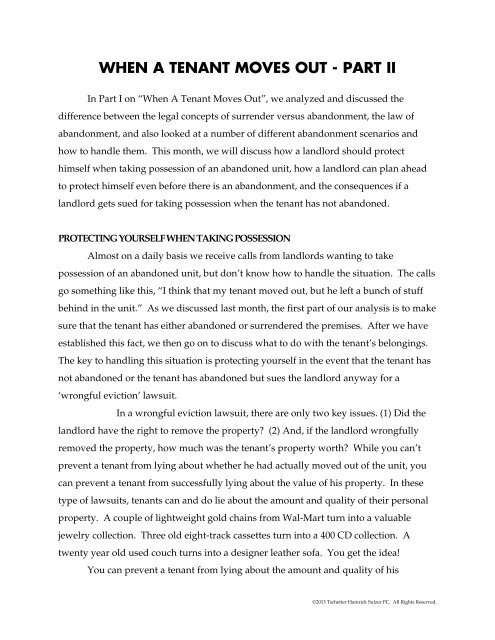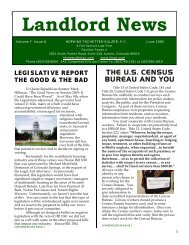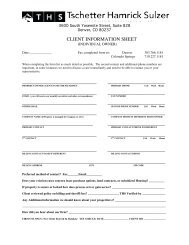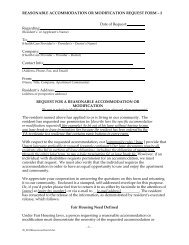WHEN A TENANT MOVES OUT - PART II - Tschetter Hamrick Sulzer
WHEN A TENANT MOVES OUT - PART II - Tschetter Hamrick Sulzer
WHEN A TENANT MOVES OUT - PART II - Tschetter Hamrick Sulzer
You also want an ePaper? Increase the reach of your titles
YUMPU automatically turns print PDFs into web optimized ePapers that Google loves.
<strong>WHEN</strong> A <strong>TENANT</strong> <strong>MOVES</strong> <strong>OUT</strong> - <strong>PART</strong> <strong>II</strong><br />
In Part I on “When A Tenant Moves Out”, we analyzed and discussed the<br />
difference between the legal concepts of surrender versus abandonment, the law of<br />
abandonment, and also looked at a number of different abandonment scenarios and<br />
how to handle them. This month, we will discuss how a landlord should protect<br />
himself when taking possession of an abandoned unit, how a landlord can plan ahead<br />
to protect himself even before there is an abandonment, and the consequences if a<br />
landlord gets sued for taking possession when the tenant has not abandoned.<br />
PROTECTING YOURSELF <strong>WHEN</strong> TAKING POSSESSION<br />
Almost on a daily basis we receive calls from landlords wanting to take<br />
possession of an abandoned unit, but don’t know how to handle the situation. The calls<br />
go something like this, “I think that my tenant moved out, but he left a bunch of stuff<br />
behind in the unit.” As we discussed last month, the first part of our analysis is to make<br />
sure that the tenant has either abandoned or surrendered the premises. After we have<br />
established this fact, we then go on to discuss what to do with the tenant’s belongings.<br />
The key to handling this situation is protecting yourself in the event that the tenant has<br />
not abandoned or the tenant has abandoned but sues the landlord anyway for a<br />
‘wrongful eviction’ lawsuit.<br />
In a wrongful eviction lawsuit, there are only two key issues. (1) Did the<br />
landlord have the right to remove the property? (2) And, if the landlord wrongfully<br />
removed the property, how much was the tenant’s property worth? While you can’t<br />
prevent a tenant from lying about whether he had actually moved out of the unit, you<br />
can prevent a tenant from successfully lying about the value of his property. In these<br />
type of lawsuits, tenants can and do lie about the amount and quality of their personal<br />
property. A couple of lightweight gold chains from Wal-Mart turn into a valuable<br />
jewelry collection. Three old eight-track cassettes turn into a 400 CD collection. A<br />
twenty year old used couch turns into a designer leather sofa. You get the idea!<br />
You can prevent a tenant from lying about the amount and quality of his<br />
©2013 <strong>Tschetter</strong> <strong>Hamrick</strong> <strong>Sulzer</strong> PC. All Rights Reserved.
property by taking photos or video of the property that was moved, set out, or thrown<br />
away. For this reason, we strongly recommend photographing all tenant property that<br />
is moved out. You don’t need to photograph every item individually. A few good<br />
shots of the pile will do. You can further bolster your position by taking a written<br />
inventory and having those involved in the move sign it. This inventory can later be<br />
used at any trial as an exhibit and to refresh witnesses’ memories. The photos and/or<br />
video and inventory will be worth a thousands words if the tenant brings suit for<br />
wrongful eviction!<br />
LEASE CLAUSES<br />
A strong lease clause addressing abandonment goes a long way to preventing or<br />
defending a wrongful eviction situation. It would seem that every lease would have an<br />
abandonment clause because the issue comes up so often. But, we review many leases<br />
that don’t have such clauses. Like almost any other lease clause, the importance of an<br />
abandonment clause is that it spells out the parties’ rights and responsibilities. A good<br />
abandonment clause is not the “be all end all” that gives the landlord the right to throw<br />
away a tenant’s belongings without taking into consideration the factual circumstances.<br />
But, a good clause explains, for both the landlord and tenant, when abandonment has<br />
occurred. If the landlord follows the procedures in the clause for determining an<br />
abandonment, he/she should be successful if the tenant sues for a wrongful eviction.<br />
The following is a lease paragraph that you are free to insert into your lease if you don’t<br />
have a similar clause.<br />
ABANDONMENT<br />
Resident covenants to occupy the Premises and shall be in default if Resident<br />
does not occupy the Premises on a regular, continuing, and consistent basis unless<br />
otherwise agreed to by Agent in writing. Resident shall have abandoned or<br />
surrendered the Premises if Resident turns in all keys or access devices regardless of<br />
whether rent is paid or not. Resident shall have abandoned or surrendered the<br />
Premises if any of the following events occur and if Resident’s personal belongings have<br />
©2013 <strong>Tschetter</strong> <strong>Hamrick</strong> <strong>Sulzer</strong> PC. All Rights Reserved.
een substantially removed, and Resident does not appear to be living in the Premises<br />
in Agent’s reasonable judgment: Resident’s move out or notice to vacate date has<br />
passed; Resident is in default for non-payment of rent for 5 consecutive days; water,<br />
gas, electric, or any other service for the Premises connected in Resident’s name has<br />
been terminated or disconnected; Agent is in the process of judicially evicting Resident<br />
for any reason; and Resident fails to respond for 2 consecutive days to any notice posted<br />
on the inside of the main entry door to the Premises stating that Agent considers<br />
Resident to have abandoned. Resident also abandons or surrenders the Premises 10<br />
days after the death of a sole resident. If Resident abandons the Premises or vacates the<br />
Premises upon the expiration or termination of this Lease while leaving personal<br />
property within the Premises, Resident specifically and irrevocably waives all title and<br />
interest Resident has to such property and grants to Agent full authority to immediately<br />
dispose of same without notice, court order, or accountability. Resident shall indemnify<br />
Agent, Agent’s employees and representatives against any claim or cost for any<br />
damages or expense with regard to the removal, disposal or storage of any property,<br />
including attorneys’ fees and costs regardless of who makes a claim against Agent or<br />
any other indemnified in connection with Agent’s removal of any property.<br />
THE WRONGFUL EVICTION LAWSUIT<br />
If a tenant believes that he has been wrongfully evicted he may sue the landlord<br />
for wrongful eviction. The whole idea of the lawsuit is that the tenant had not<br />
abandoned the unit, was still living there despite the indications that he had moved out,<br />
and the landlord is responsible for paying damages. Even if the landlord has a strong<br />
abandonment lease clause, has taken pictures of the junk that was thrown out, and<br />
followed all the proper procedures, this will not necessarily keep a tenant from suing.<br />
Tenants will file groundless lawsuits and there is no way to stop them. But, the better<br />
the landlord’s documents, photos and procedures, the more likely the landlord will<br />
prevail at trial.<br />
In most any lawsuit the plaintiff (tenant) has to prove two elements in order to<br />
win a monetary judgment. The first element is liability – did the landlord wrongfully<br />
©2013 <strong>Tschetter</strong> <strong>Hamrick</strong> <strong>Sulzer</strong> PC. All Rights Reserved.
evict the tenant when in fact the tenant had not abandoned. The second element is<br />
damages – what is the value of the tenant’s belongings and other consequential<br />
damages such as moving expenses. If the defendant (landlord) is able to defeat either<br />
one or both of the elements he will win the lawsuit. He will argue that he is not liable<br />
(first element) because the tenant moved out of the unit and that the tenant’s actions<br />
indicated that the he intended to relinquish control of the unit. The landlord will also<br />
argue that the tenant’s belongings had no value (second element), therefore, the tenant<br />
did not suffer any damages. Last month’s article discussed the legal standards of<br />
abandonment which go the first element. The following looks at damages.<br />
If the tenant is able to prove that the landlord is responsible for the wrongful<br />
eviction the court determines the measure of damages. Every tenant and many lawyers<br />
that the Firm has fought in a wrongful eviction believe that the measure of damages is<br />
the purchase price or the replacement cost of the goods. This couldn’t be further from<br />
the truth. Under Colorado law, the amount of damages a tenant can receive for<br />
personal property is not its replacement cost but rather its fair market value - what a<br />
willing disinterested party would pay for the property. Anyone that has been to the<br />
flea market knows that a person’s used personal property has little or no value to<br />
anyone other than its owner. This is why it is so important to take photos/video and<br />
make an inventory list because a court is not likely to award substantial damages to the<br />
tenant if you can prove the property at issue was used and of little value.<br />
Unfortunately, not all judges follow the law and use the fair market value<br />
standard. We have run into a few judges that will allow a tenant to testify as to the<br />
purchase price of the lost items (which should be irrelevant) as an indicator of the fair<br />
market value. For example, Ronnie Resident purchased the sofa ten years ago. The<br />
landlord threw the sofa away because it was 10 years old, looked like it had been<br />
through a war, and was left behind. Of course, Ronnie testifies that the couch was in<br />
great shape and he had paid $2,000 for it, so it must still be worth at least $1,000. In<br />
reality, the sofa is only worth $50 (if that) but because the judge considered the high<br />
purchase price, he awards Ronnie $500 in damages. There is no way around bad<br />
judges!<br />
©2013 <strong>Tschetter</strong> <strong>Hamrick</strong> <strong>Sulzer</strong> PC. All Rights Reserved.
In addition to the actual value of the tenant’s belongings, a tenant might be<br />
entitled to other damages. Under Colorado law, the tenant is entitled to all damages<br />
that are the actual, natural, direct and proximate result of the wrongful eviction. Beside<br />
the value of the property, this includes the cost of moving and compensation for the<br />
time and money spent in pursuit of the converted property.<br />
A third element of damages is punitive damages. The court has the right to enter<br />
an award of punitive damages against the landlord to punish the landlord for his<br />
actions. The amount of punitive damages is limited to the amount of actual damages in<br />
most circumstances. In other words, if the tenant proves $2,000 in actual damages the<br />
most the punitive damages can be is $2,000. In order for the tenant to receive punitive<br />
damages, the landlord must have acted in such manner as to constitute wanton and<br />
reckless disregard of the tenant’s rights. The fact that the landlord wrongfully throws<br />
away the tenant’s property under a mistaken belief is not enough to establish punitive<br />
damages. The tenant has to prove the wanton and reckless elements.<br />
In one Colorado case, the landlord did not receive rent and instead of filing an<br />
eviction, locked the tenant out of the unit and would not return the tenant’s property<br />
upon the tenant’s request. The court found this action to be wanton and reckless and<br />
awarded punitive damages.<br />
There is a final issue to consider in a wrongful eviction lawsuit. Most of the time,<br />
the landlord will have an offset against the tenant for failure to pay rent. Nearly all of<br />
the wrongful eviction cases exist because the tenant has moved out before the lease<br />
expires and the tenant owes rent or a lease break fee. The landlord is legally entitled to<br />
offset his damages against the damages for the wrongful eviction. In some cases the<br />
landlord’s claim is actually greater than the tenant’s and the landlord comes away from<br />
court with a judgment! The landlord can also use the threat of his claim to try to settle<br />
the case before it even gets to court at all.<br />
Even if you had the absolute right to remove or throw away the property, there<br />
simply is no guarantee that the judge will rule in your favor on this issue. Thus, if you<br />
are unfortunate enough to lose the liability issue in one of these lawsuits, you can<br />
greatly reduce your potential exposure through the use of photographs and/or videos<br />
©2013 <strong>Tschetter</strong> <strong>Hamrick</strong> <strong>Sulzer</strong> PC. All Rights Reserved.
and inventory lists. In fact, many tenants or their attorneys actually drop these<br />
groundless suits when provided with this type of strong and irrefutable evidence.<br />
©2013 <strong>Tschetter</strong> <strong>Hamrick</strong> <strong>Sulzer</strong> PC. All Rights Reserved.







